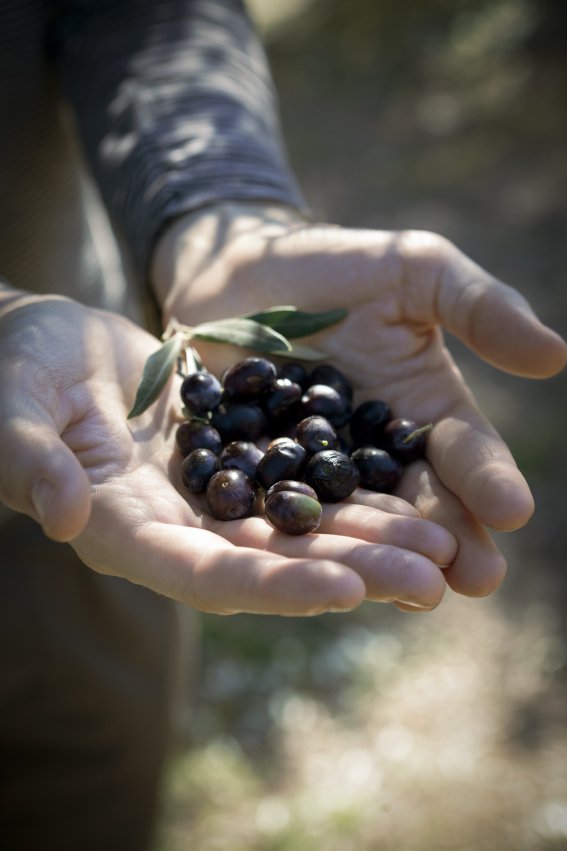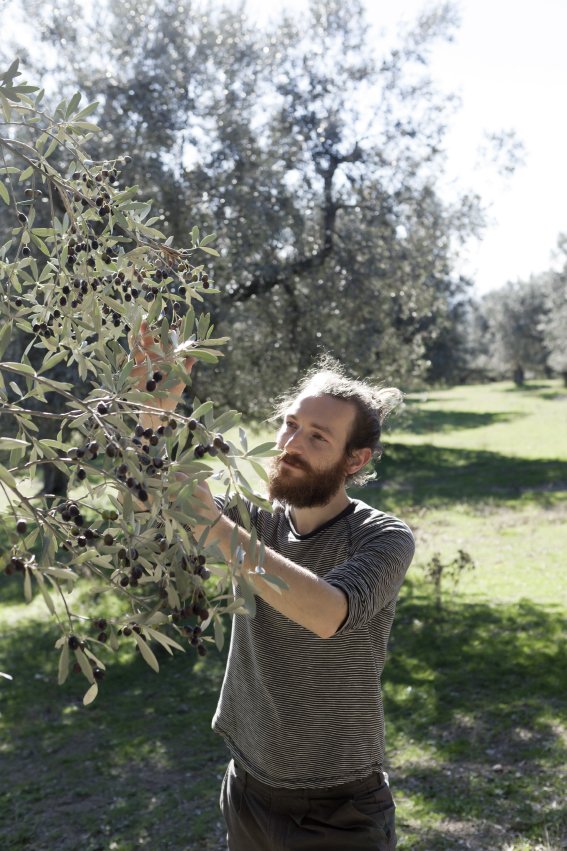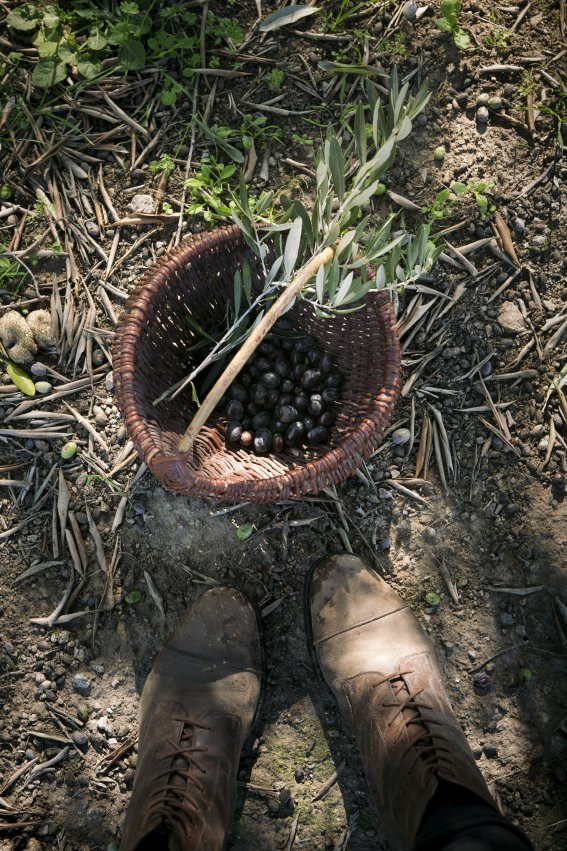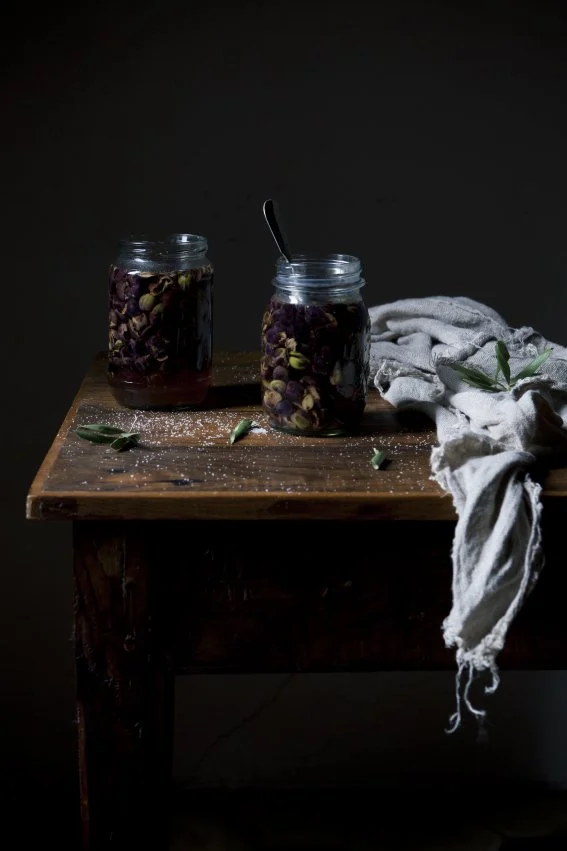A tale of olives
and love for Maremma
Since I was a child, I have viewed a sea of olive trees as if they were a natural extension of my beautiful window, from my house in Tuscany. An edgeless balcony that stretches far out into the sea, the real one. Many of the olive trees scattered on the hills of this valley in Maremma are over a hundred years old.
I know this place very well and I can move around easily without getting lost. Sometimes, I like to pay the olive trees a visit, thinking of them as the guardians of this land and of the many people who have passed through here.
While I’m wandering around the olive grove, at a certain time of the year, I can hear their voices in the wind but, in getting closer, I realize where the voices are actually coming from. Under one of the trees, someone is picking the olives that are now ready to be harvested. In passing near some of the workers, they immediately greet me. Some are having a rest and are slicing bread and pecorino cheese or ham, some are collecting the sacks that are full of olives, while others are spreading the nets well around the roots of the trees.
Olive picking means long hours, from dawn till dusk, and many days of hard work.
In this area, they use a small rake for “combing” the branches so that the olives fall down into the nets. The olives are then separated from twigs and leaves and hand-picked one by one and put into sacks or crates.
The time required for doing all this seems to be already set and is slow. Up and down the ladders, up and down, as if to follow the shape of the hills. The harvested olives are then taken to the mill, called frantoio where the precious oil is extracted.
In the past, the frantoio with its huge stone wheels, earthenware jars, piles of the soaked felt disks used for several olive pressings, and the pungent fragrance that was always in the air appeared almost like a place of alchemy.
It was always bustling with people and carts going in and out and it was an indication of a well-organized local economy. When someone needed to buy some oil, they went to their local frantoio to refill their empty bottle.
The organic oil was thick and had a dark green color that we can properly define as olive green. It was something special, as special were the large stone wheels that went around and round all the time, and special was the ladle that was used for scooping the desired amount of the thick rich oil. To be able to see all this, at least once in a lifetime, is like having a glimpse into the past.
Today, the frantoio has changed a lot and it’s impossible to see the oil being processed because it is immediately poured and sealed, for convenience and hygiene, into tins. Business is only at the time of olives production, then afterward everything stops until the following year.
Towards the end of the day in Maremma, the light is enchanted with golden and amber streaks similar to those of the olive wood grain, and they are smooth and warm.
While everyone is making their way to return home, at the frantoio the work doesn’t stop but carries on into the night in order to make the precious oil whose color is a deep green and has a peppery taste.
There are still some old ladders against the trunk of the trees, maybe someone had left them from the last harvesting. I wonder how long these ladders have been used; how many hands have touched them; how many feet have climbed up. They have been left under the sun and in the rain, in every season of the year. The silence around here seems to underline their solitude.
Olive trees are elegant, lush, and generous, and will thrive if their roots find well-drained soil to hold on to. However, although they are so familiar to me, and I know the different varieties of olives, I have only recently discovered I didn’t know about the most obvious and important fact about olives, which is that ripe freshly picked olives are uneatable due to their bitterness! After having erased from my mind the naive idea that olive trees bear ready-to-eat fruits, I went to take some proper lessons from those who know a thing or two about olive picking and its preservation.
I wanted to know how to prepare the olives, I mean, to make them edible… and I have discovered that this task requires a lot of patience.
First of all, you must get rid of the bitterness of the freshly picked olives by following the various steps required, which are the daily changing of the water using pure water at first, and salt and water later.
The treatment for unpitted olives takes at least one month if you want to have a good result.
After having done the curing, and when the bitterness has finally gone, we are left with the olive flesh. At this point, comes the final part, which is also the easiest part.
You can use them as you like, or try my recipe below.
I have been told that in the past, people used to keep a few small sacks of olives near their fireplace or their stove, possibly for the whole winter, so that the olives would dry up slowly.
I’m sure that every elderly person in this town has a different story to tell on this matter, and, as it often happens, recipes are then passed on. Sometimes, they are written down and kept; sometimes, they are orally narrated, as if they were some old tales.
This recipe is one of them. Passed from one place to another, from Maremma to Venice, from one kitchen to another, like something precious to be preserved.
THE CURSING METHOD
The olives I'm talking about in this post are called “moraiola”, a very common and much sought-after type of olive in central Italy. They are small and round, with not much flesh but very tasty. All varieties of olives must be treated to lose their bitterness and so become edible. This is a slow but essential process that needs to be done daily for about a week. *Note: Here I'm giving the time that I have used for curing this specific type of olive, before passing to the next step where I explain how to make homemade black olives tapenade. For this method, the olives are pitted immediately to speed up the process of leaching out the bitter liquid but it is not the method for curing unpitted olives which require different times (about a month!).
Ingredients:
black olives
fine salt
water
Instructions:
With a knife or using a specific tool, remove the stones from the olives. Place the pitted olives in a large bowl, preferably made of glass. *(after a little while your nails and fingers will turn black and a little sticky but it is a task impossible to do if wearing gloves).
Fully cover the olives with cold water and leave them for 3 days, changing the water twice a day, morning and evening.
Then, a further 4-5 days of soaking in cold salty water. Change the salty water only once a day and stir the olives from time to time. You should use the right amount of salt, which is about 50g of salt for every liter of water. Depending on the quantity of olives to be cured, use the right amount of water to cover them completely.
When the soaking time is over, the olives will have leached out their bitterness and will be ready for the next step.
Taste one and if they are still bitter, extend the soaking process a bit longer.
OLIVE TAPENADE
Olive tapenade can be made with different kinds of olives, either black or green, and flavored with a variety of the other ingredients that you like best. I have used the olives known as “moraiole”, after having previously cured them.
The tapenade can be used in several ways, the easiest of which is on a warm slice of bread. I also like to use it as a sauce for pasta or spread it on pizza instead of tomato sauce.
Ingredients:
*Quantities vary according to the amount of olives. I have used about ½ kg of pitted olives to make about 4-5 medium size jars of tapenade.
Black olives (of your choice)
Extra-virgin olive oil
Fine salt
Additional ingredients of your choice for flavoring:
Quantities can vary according to your taste. I have abounded with parsley and capers, but be careful not to use too much garlic and anchovies, as they might overshadow the taste of the olives.
Parsley
Garlic
Capers
Organic orange peel
Fennel seeds to garnish
I have mixed the ingredients as follows:
parsley + garlic + capers
parsley + garlic + capers + anchovies
parsley + garlic + orange peel
Instructions:
Mix together the pitted and well-drained olives with the ingredients of your choice and the extra-virgin olive oil (a quarter of the amount used for each jar) and a good pinch of salt.
Blend with a food processor until you have a creamy smooth paste.
Fill the jars (previously sterilized) with the tapenade, making sure you cover the tapenade with the rest of the olive oil.
If you like add some orange peel to the top of the oil if your ingredient mixture requires it, or add some fennel seeds.
Close the lid well and keep it in the fridge. It can keep for up to 15 days.














